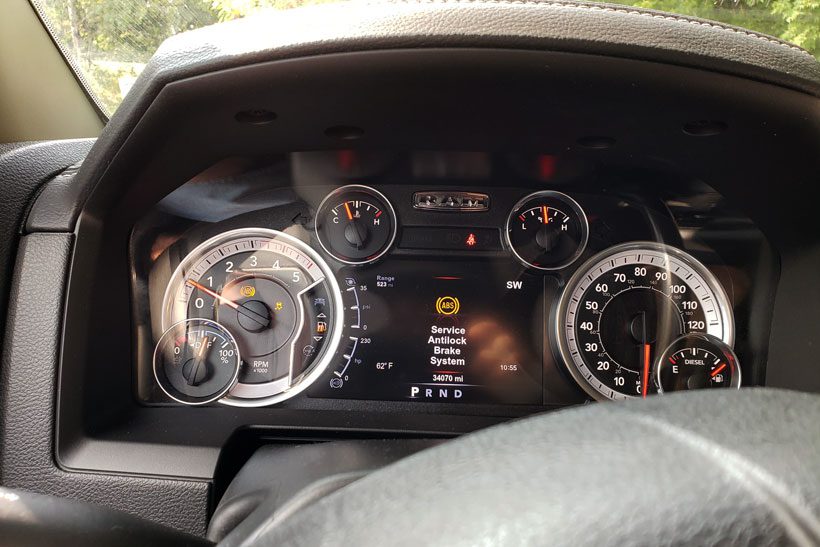Dodge Ram 2500 ABS Warning Light On: Reasons and Resetting Tips
When the ABS light of your Dodge Ram 2500 starts flashing, it means something is wrong with the braking system. However, sometimes the warning light comes on even when the brake is working fine. It indicates that your car components related to the ABS might be malfunctioning.
Wondering what causes the Dodge Ram 2500 ABS warning light on? In general, it’s the damaged or dirty wheel speed sensors and a bad relay that cause the ABS light issue. Low brake fluid and tire pressure, and ABS module failure can also be the culprit.
Let’s get into the details and explore all the different reasons why the anti-lock braking system light keeps coming on.
Why Is the ABS Light Illuminated On My Dodge Ram 2500? – Easy Fixes
The anti-lock braking system (ABS) of your Dodge RAM 2500 consists of several working components. If any of these components go bad, the ABS will malfunction and the braking light will turn on.

Here are the common reasons why your Dodge Ram 2500’s ABS light keeps coming on:
Reason One – Damaged or Dirty Wheel Speed Sensors
From what we’ve seen so far, damaged or dirty wheel speed sensors are the main reasons why the ABS warning light turns on.
Each wheel of your Dodge Ram 2500 has a sensor that measures the rotational speed of the wheel. The sensors generate an electric signal and send it to the control module to process the data.
As the wheel speed sensors are usually located on the wheel hub, they are exposed to environmental factors such as dirt, heat, and mechanical damage. Therefore, the sensors easily get damaged by regular wear and tear.
Also, grime and dirt can prevent the sensors from sending electric signals causing the ABS light to turn on.

What’s the Fix?
Thankfully, you can easily detect damaged sensors and replace them if you have passable experience with automotive parts. Here’s the process-
- Before you start, remove the negative terminal of your car battery to cut off the power supply. Use a jack to lift your car and hold it in a comfortable position where you can easily access the wheels
- Now it’s time to locate the wheel sensor. On a Dodge Ram 2500, the wheel sensor is typically integrated into the wheel hub assembly or mounted on the brake caliper. It’s made of plastic or metal and contains a coil of wire.
The sensor body is encased in a protective housing and one end of the sensor has a connector or plug for attaching the connecting cable
- Once you’ve located the sensor, visually inspect it for any type of damage or grime buildup. If it’s only dirt, cleaning the sensor will solve this issue. However, when the damage is undesirable, you must replace the sensor to fix the ABS
- To replace the sensor, remove the electrical connector or plug from one end of the sensor. Use a socket set or similar tools to remove screws and bolts that hold the sensor in place
- Now, you can take the damaged sensor out using your hands. Remove any retaining clip that might attach the sensor to the car
- After detaching the damaged sensor, you can easily place the new wheel sensor on the mounting hole. Ensure proper alignment and plug in all the related cables and clips to connect the new sensor to the vehicle
- When you’re done, reconnect the car battery and test the new sensors. Check out this video if you need some visual aid
Reason Two – Bad Relay or Blown ABS Fuse
While discussing the ABS light issue, users have pointed out that it can be caused by the electric system which includes the ABS fuses and relay. The ABS requires stable power flow to function properly, providing power to the ABS.
While the fuse protects the circuit and prevents electrical damage, the relay controls the flow of power to the ABS module. Therefore, any damage to the relay or the fuse can fail the whole system and the warning light will turn on consequently.
What’s the Fix?
Locate the fuse and relay box of your Dodge Ram 2500 and look for signs of corrosion or damage. You have to replace the damaged components if you find any. Here’s the process-
- On a Dodge Ram 2500, the ABS relay and fuses are located inside the fuse box. Typically, the fuse box is placed under the hood inside the engine compartment. However, check out your owner’s manual or the fuse diagram to know the exact location of the fuse box
- Once you find the box, unplug your car battery and visually inspect the ABS relay and fuses for signs of damage. If the wire inside a fuse has broken or turned black, you need to replace it
- Take out the blown fuse or damaged relay using pliers. Note the ampere rating on the fuse and get a new one with the same rating. Similarly, make sure the new relay is compatible with your vehicle
- Install the new fuse or relay and connect it to the fuse box properly. When you’re done, reconnect the battery and see if the ABS light has turned off
Reason Three – ABS Module Failure
The electric signal provided by the wheel sensors is processed by the ABS control module. It controls the wheel locking mechanism and coordinates ABS operation.
In case of a fault or malfunction within the ABS, the ABS module triggers the ABS warning light on the dashboard to alert the driver about the issue. However, when the ABS control module fails, it can send the wrong data or no data at all and trigger the ABS light.

What’s the Fix?
In this case, you must consult an expert mechanic as the ABS module is a complex part. Before suggesting a solution, we want you to be sure that the ABS module is actually malfunctioning.
Connect an OBD-II scanner to check if there’s any trouble code such as U0121 or C0265, it indicates a faulty control module.
Depending on the nature of the code, the mechanic will perform either of these two actions-
- Reset the ABS control module and erase the trouble codes
- If that doesn’t work, the control module has to be replaced
Users have said that the warning light turns off after the replacement. As the replacement process is complex and time-consuming, you must take your vehicle to an expert to replace the control module.
Reason Four – Insufficient Brake Fluid
If the brake fluid level is lower than standard, the ABS will read this as a potential leak or malfunctioning hydraulic pump. Also, the ABS relies on hydraulic pressure to function properly.
Low brake fluid levels can affect the system’s ability to operate effectively. As a result, the system will malfunction and the ABS light will turn on.

What’s the Fix?
Inspect the brake fluid reservoir of your Dodge Ram 2500 to see if the fluid level is lower than the required level. After that-
- First, top off the reservoir and make sure the fluid level is near the high mark of the reservoir tank. Also, if the fluid looks too old or dirty, you need to change the brake fluid
- Look for leaks or damage in the reservoir. If there are any, you might have to replace the fluid reservoir
Reason Five – Low Tire Pressure
Although rare, the ABS light can turn on when your tires aren’t inflated. A puncture or any other damage to the truck wheel can lower the tire pressure. The deflated tire spins faster than the inflated one.
When your Ram’s ABS control module detects this change in speed, the system triggers a DTC code (U140D or U1412) for the wheel sensor of the deflated tire. Hence, the ABS warning light and the TPMS light start flashing on your dash.
What’s the Fix?
To get rid of the ABS light, follow these steps-
- Inflate your tire to the recommended pressure level. Replace the tire if it’s worn out or damaged
- If the issue persists, you need to connect an OBD-II scanner tool to your Dodge Ram 2500 and clear off the DTC codes
Reason Six – Bad ABS Pump Or Control Module
One key component of the ABS of your Dodge Ram 2500 is the ABS pump. It regulates the hydraulic pressure in the braking system. When the ABS pump malfunction, it causes the ABS light to illuminate.
On the other hand, the control module receives and processes the signal sent by the wheel sensors. It detects whether the system is working and the wheels are rotating at the right speed. So, if the module goes bad, the ABS will fail and it will trigger the warning light.

What’s the Fix?
As the ABS pump and control module are complex parts that must be handled carefully. We recommend taking help from a professional mechanic to fix the parts.
In most cases, the pump and module are not repairable, so they need to be replaced. It will cost you anywhere from $300 to $1,000 to replace them with new or refurbished ones. Thus, make sure the replacement is done by a professional mechanic.
If you’re experiencing an ABS warning light issue in your Dodge Ram 2500, you may find our article on Honda Pilot ABS light on helpful. Although it’s specific to the Honda Pilot, it provides insights and potential solutions that may be applicable to your Dodge Ram 2500 as well. Additionally, if you own a Toyota Prius and are dealing with brake light and ABS light on, you can check out our article on Toyota Prius brake light and ABS light on for further information and troubleshooting tips specific to that vehicle.FAQs
Got any more queries? Let’s address some commonly asked questions users often have regarding their Dodge Ram 2500’s ABS light.
To fix your ABS light by resetting, first, disconnect your vehicle’s battery. Get into your car and press your brake pedal for a few moments. This will drain the electric system of your vehicle. As a result, the vehicle’s central computer will reset the ABS and the warning light will turn off.
In general, the ABS light turns on and goes off while the system is checking itself. It’s normal for the ABS and typically lasts for a few moments only. However, sometimes the warning light blinks due to temporary glitches.
Yes, you can drive a truck with an ABS light on, but you must be aware of the consequences. The ABS light indicates that the anti-lock braking system isn’t functioning properly.
Therefore, in case of sudden or hard braking, the wheels could potentially lock up. It might result in a loss of control or longer stopping distances.
Wrapping Up!
So, that was all about the Dodge Ram 2500 ABS warning light on issues. Typically, it’s the dirt or corrosion of the wheel sensors that trigger the ABS light. It can also be caused by a blown fuse, insufficient braking fluid, and a faulty control module.
If you’ve checked all these and the issue persists, inflate your car tires or reset the ABS. While some fixes like changing the wheel sensors or topping off the fluid reservoir are easy, you must consult a professional for more complex ones.

